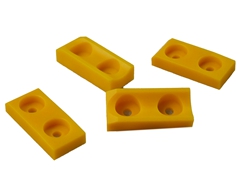Process selection of different polyurethane and metal bonding
 Process selection of different polyurethane and metal
bonding
Process selection of different polyurethane and metal
bonding
To make the
product easier to remove from the mold, a release agent is required. Be
extremely careful when using release agents. Generally, it is not recommended
to use silicone oil. Avoid squeezing the release agent onto the bonding
interface between the metal and the CPU elastomer during the pouring process to
affect the bonding strength. When the CPU is poured on the metal, as the
product vulcanizes, the bonding strength between the CPU elastomer and the
metal also increases. When the product is just released from the mold, the
bonding strength is still relatively low, so it must be handled carefully.
As for the
products that need to be bonded, some need to be compression molded, and some
are not. For compression molded products, it is particularly important to grasp
the timing of mold closing. Too early, there is easy to have bubbles in the
product; too late, it is easy to crush the glue or cause the flash to be too
thick, which is not conducive to bonding. Moreover, when the product is
demolded, the mold temperature is higher, and the bonding strength is not high
at this time. Therefore, for rubber rollers and rubber wheels, the temperature
of the mold should be lowered before demolding to shrink the glue layer and
then demolding. It is much easier and will not affect the bonding strength, but
it will affect the production efficiency, which should be determined according
to the specific situation. Compression molding vulcanization will increase the
difficulty of demolding, so the normal pressure vulcanization molding process
is generally used for products that are easy to machine such as rubber rollers
and rubber wheels.










